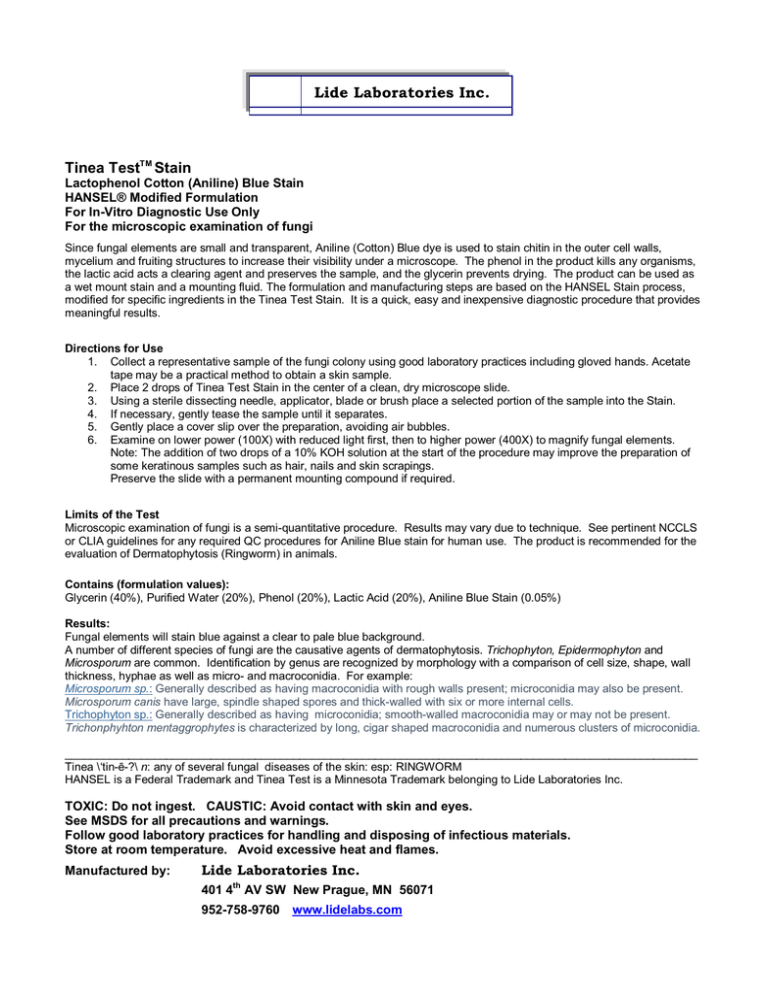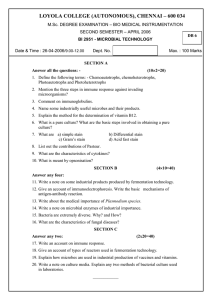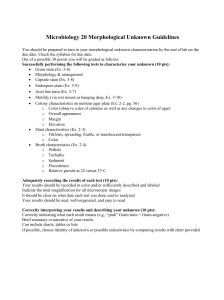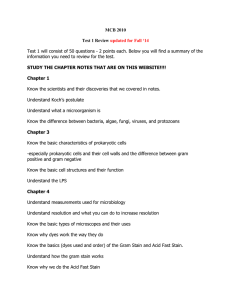Tinea Test Stain docs pdf
advertisement

Lide Laboratories Inc. Tinea TestTM Stain Lactophenol Cotton (Aniline) Blue Stain HANSEL® Modified Formulation For In-Vitro Diagnostic Use Only For the microscopic examination of fungi Since fungal elements are small and transparent, Aniline (Cotton) Blue dye is used to stain chitin in the outer cell walls, mycelium and fruiting structures to increase their visibility under a microscope. The phenol in the product kills any organisms, the lactic acid acts a clearing agent and preserves the sample, and the glycerin prevents drying. The product can be used as a wet mount stain and a mounting fluid. The formulation and manufacturing steps are based on the HANSEL Stain process, modified for specific ingredients in the Tinea Test Stain. It is a quick, easy and inexpensive diagnostic procedure that provides meaningful results. Directions for Use 1. Collect a representative sample of the fungi colony using good laboratory practices including gloved hands. Acetate tape may be a practical method to obtain a skin sample. 2. Place 2 drops of Tinea Test Stain in the center of a clean, dry microscope slide. 3. Using a sterile dissecting needle, applicator, blade or brush place a selected portion of the sample into the Stain. 4. If necessary, gently tease the sample until it separates. 5. Gently place a cover slip over the preparation, avoiding air bubbles. 6. Examine on lower power (100X) with reduced light first, then to higher power (400X) to magnify fungal elements. Note: The addition of two drops of a 10% KOH solution at the start of the procedure may improve the preparation of some keratinous samples such as hair, nails and skin scrapings. Preserve the slide with a permanent mounting compound if required. Limits of the Test Microscopic examination of fungi is a semi-quantitative procedure. Results may vary due to technique. See pertinent NCCLS or CLIA guidelines for any required QC procedures for Aniline Blue stain for human use. The product is recommended for the evaluation of Dermatophytosis (Ringworm) in animals. Contains (formulation values): Glycerin (40%), Purified Water (20%), Phenol (20%), Lactic Acid (20%), Aniline Blue Stain (0.05%) Results: Fungal elements will stain blue against a clear to pale blue background. A number of different species of fungi are the causative agents of dermatophytosis. Trichophyton, Epidermophyton and Microsporum are common. Identification by genus are recognized by morphology with a comparison of cell size, shape, wall thickness, hyphae as well as micro- and macroconidia. For example: Microsporum sp.: Generally described as having macroconidia with rough walls present; microconidia may also be present. Microsporum canis have large, spindle shaped spores and thick-walled with six or more internal cells. Trichophyton sp.: Generally described as having microconidia; smooth-walled macroconidia may or may not be present. Trichonphyhton mentaggrophytes is characterized by long, cigar shaped macroconidia and numerous clusters of microconidia. ____________________________________________________________________________________________________ Tinea \‘tin-ē-?\ n: any of several fungal diseases of the skin: esp: RINGWORM HANSEL is a Federal Trademark and Tinea Test is a Minnesota Trademark belonging to Lide Laboratories Inc. TOXIC: Do not ingest. CAUSTIC: Avoid contact with skin and eyes. See MSDS for all precautions and warnings. Follow good laboratory practices for handling and disposing of infectious materials. Store at room temperature. Avoid excessive heat and flames. Manufactured by: Lide Laboratories Inc. 401 4th AV SW New Prague, MN 56071 952-758-9760 www.lidelabs.com IDENTITY (As Used on Label and List) The statements contained are offered as information only and are believed to be accurate and represent the best information currently available. However, we make no warranty, expressed or implied, with Tinea Test Stain respect to such information and assume no liability of any type resulting from its use. Users of the product should make their own investigations to determine suitability of the information for their particular purposes. Section I: Manufacturer's Name: Emergency Telephone Number: 952-758-9760 or Lide Laboratories Inc. contact a local medical facility Address (Number, Street, City, State, and Telephone Number for Information: 952-758-9760 ZIP Code) 401 4th AVE SW Date Prepared: 11/4/2012 Signature of Preparer (optional) New Prague, MN 56071 Section II - Hazardous Ingredients/Identity Information Lactic Acid (20%) CAS# 50-21-5, Phenol (20%) CAS# 108-95-2, Glycerin (40%) CAS# 56-81-5 Purified Water, Aniline Blue CAS# 28631-66-5 EMERGENCY OVERVIEW DANGER! POISON! May be fatal if swallowed, inhaled, or absorbed through the skin. CAUSTIC! Harmful if absorbed through the skin. HARMFUL VAPOR! May cause eye and respiratory tract irritation. May affect the central nervous system, liver and kidneys. Cannot be made non-poisonous. Safety Ratings: Health 3, Severe (Poison), Reactivity 0 (None), Flammability 1, (Slight), Contact 2 (Moderate) Protective Equipment: Gloves, Goggles, Local or General Exhaust Ventilation Storage Code: Blue - Health Hazard Section III - Physical/Chemical Characteristics Appearance and Odor: Blue in color, slight phenolic, alcoholic odor. Section IV - Fire and Explosion Hazard Data Extinguishing Media: For small fires, use dry chemical, carbon dioxide, water spray or alcoholresistant foam. Water may be ineffective. For large fires, use water spray, fog or alcohol-resistant foam. Do NOT use straight streams of water. Special Fire Fighting Procedures: As in any fire, wear a self-contained breathing apparatus in pressure-demand, MSHA/NIOSH (approved or equivalent), and full protective gear. During a fire, irritating and highly toxic gases (CO, CO2) may be generated by thermal decomposition or combustion. Extinguish all nearby sources of ignition. Section V - Reactivity Data Chemical Stability: Stable under normal temperatures and pressures. Conditions to Avoid: High temperatures, ignition sources, confined spaces. Hazardous Decomposition Products: Carbon monoxide, carbon dioxide Hazardous Polymerization: Will not occur. Section VI - Health Hazard Data Health Hazards (Acute and Chronic) DANGER! POISON! CAUSTIC! HARMFUL VAPOR! May be fatal if swallowed. Harmful if swallowed, inhaled, or absorbed through the skin. Causes eye, skin, and respiratory tract irritation. May cause central nervous system depression. Cannot be made non-poisonous. Emergency and First Aid Procedures Eyes: In case of contact, immediately flush eyes with plenty of water for at least 15 minutes. Get immediate medical attention. Stain will stain eyes. Ingestion: Immediately administer castor oil or other vegetable oil (15-30 mL), Do not give to an unconscious person. Contact medical personnel or poison control center. Be ready to induce vomiting at the advice of medical professional. Inhalation: If inhaled, remove to fresh air. If not breathing, give artificial respiration. If breathing is difficult, give oxygen. Get medical aid. Skin: Phenol will penetrate the skin rapidly and is corrosive on the body tissues causing burns. In case of contact, immediately wash skin with plenty of soap and water for at least 15 minutes while removing contaminated clothing and shoes. Stain will stain skin. Get medical attention. Notes to Physician: Effects may be delayed. Chronic potential health effects such as rapid absorption of phenol may cause systemic poisoning. Section VII - Precautions for Safe Handling and Use Steps to Be Taken in Case Material is Released or Spilled: Use proper personal protective equipment as indicated in Section VIII. Avoid direct contact with the product. Product will stain the skin. Absorb spill using an absorbent, non-combustible material such as hazmat absorbent pads or vermiculite. Do not use combustible materials such as sawdust. Use a spark-proof tool. Provide ventilation. A vapor suppressing foam may be used to reduce vapors. Water spray may reduce vapor but may not prevent ignition in closed spaces. Waste Disposal Method: Chemical waste generators must determine whether a discarded chemical is classified as a hazardous waste. US EPA guidelines for the classification determination are listed in 40 CFR Parts 261.3. Additionally, waste generators must consult state and local hazardous waste regulations to ensure complete and accurate classification. Empty containers retain product residue, (liquid and/or vapor), and can be dangerous. Precautions to Be taken in Handling and Storing Handling: Avoid contact with eyes, skin, and clothing. Do not ingest or inhale. Use only with adequate ventilation. Keep away from heat, sparks and flame. Avoid use in confined spaces. Follow good laboratory practices and product use instructions. Storage: Keep container tightly closed. Keep away from heat, sparks, and flame. Keep away from sources of ignition. Store in a cool, dry, well-ventilated area away from incompatible substances and out of direct sunlight. TOXICOLGY Summary: Phenol: Oral rat LD50 317-340 mg/kg, Inhalation rat LC50 316 mg/m 3 Investigated as a tumorigen, mutagen, reproductive effector. Lactic Acid: Oral rat LD50 3543-3730 mg/kg, Investigated as mutagen. Glycerin: Oral LD50 12,600 mg/kg Investigated as a mutagen and reproductive effector. ECOLOGICAL Summary: This material is expected to be toxic to marine life. TRANSPORTATION Information: US DOT Shipping Name - Phenol Solution, Hazard Class 6.1, UN2821, Packing Group III Note: 25 mL Tinea Test Stain shipped as “Small Quantity” Section VIII - Control Measures Engineering Controls:. Facilities storing or utilizing this material should be equipped with an eyewash facility and a safety shower. Use adequate general or local exhaust ventilation to keep airborne concentrations below the permissible exposure limits. A fume hood and Class B extinguisher are recommended. Personal Protective Equipment Eyes: Wear chemical splash goggles. A face shield may be necessary. Skin: Wear butyl rubber gloves, apron, and/or clothing. Clothing: Wear appropriate protective clothing to prevent skin exposure. Respirators: Follow the OSHA respirator regulations found in 29 CFR 1910.134 or European Standard EN 149. Use a NIOSH/MSHA or European Standard EN 149 approved respirator if exposure limits are exceeded or if irritation or other symptoms are experienced. Reproduced locally (11/2012) OSHA 174, Sept. 1985 * U.S.G.P.O.: 1986 – 491 – 529/45775


